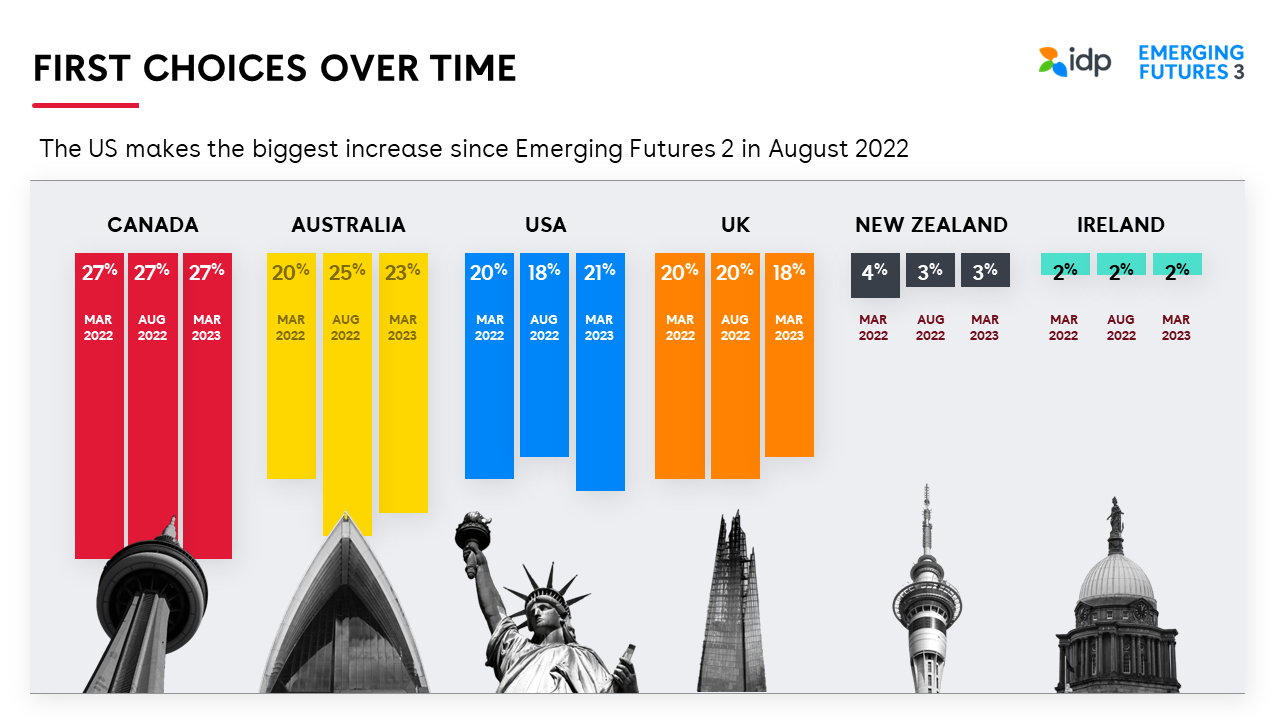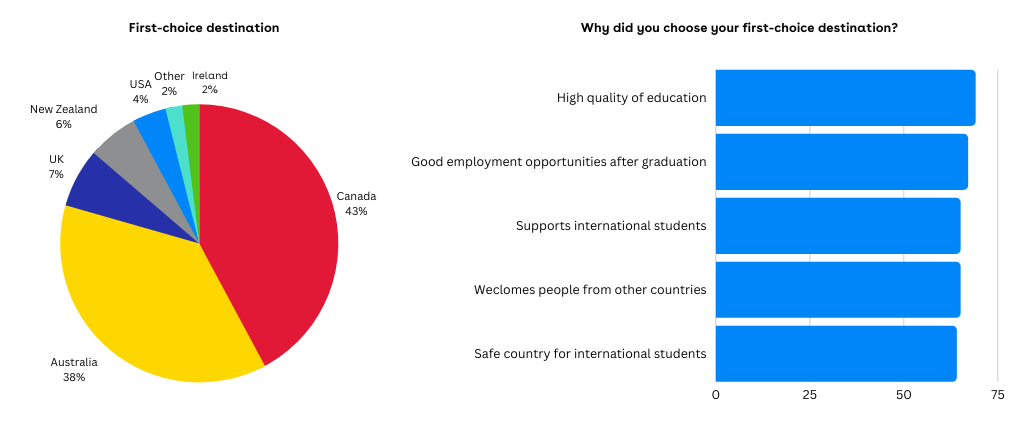Providing international students with the best-fit study experience should always start with an understanding of what they want, so IDP’s Emerging Futures research asks students (prospective, applied, current and completed) which countries they are considering or considered when choosing their international study destination and why.
Our IQ data platform allows us to drill down into the results to see the choices within different source markets and the trends over time. In this article, we explore how the respondents in individual countries differ in respect of their first-choice study destinations. We will also attempt to use the data to see if there are any correlations that can be turned into actionable insights.
The global situation
From IDP respondents across the globe (a cohort of 13,498) and across all points in their education journey, the EF3 cohort told us that Canada was the most desired destination. It was the first-choice study destination for more than a quarter (27%) of the cohort making. Australia came in second (23%), then USA (21%), UK (18%), New Zealand (3%), Ireland (2%). Other destinations accounted for 5% of the destination first choices.

Since March 2022, Canada has remained stable at the top of the first-choice polls, While Australia’s popularity increased in our August 2022 research but has since dropped two percentage points. The USA’s share of first-choice polling dropped in August 2022, but then increased in March 2023. The UK has dropped two percentage points in the latest research and was the first-choice destination of only 18% of the IDP respondents.
How do students from different source market countries choose?
Our Emerging Futures 3 research enables us to look at individual source market countries to find out where the students are choosing to study and why. Here we focus on IDP respondent customers from seven student-sending countries, asking all students what country they chose as their first-choice study destination and why they chose it.
Students from all seven countries chose “high quality education” as the top factor for determining whether a country would be their first choice, so we will also look at what prospective students told us about the factors they considered important when attempting to understand whether an institution provides “high-quality education”?
Bangladesh
Students from Bangladesh are the smallest cohort in this comparison and the number of respondents remained consistent with the previous Emerging Futures 2 (EF2) research carried out in August 2022. More than two thirds of the respondents in this group chose one of the big four study destinations as their first choice. Canada increased its share of first-choice respondents from the EF2 research carried out in August 2022 by one percentage point. USA fell to third, dropping three percentage points, and Australia increased its share by six percentage points. UK also lost out by three percentage points but remained in fourth spot.

What factors are important to students in understanding if an institution provides "high quality education"? (Prospective students – top-five only)
Facilities available to students
Cost of tuition fees
Graduate employment rate
Institution ranking
Quality of the institution’s response to enquiries
When this final question was asked of current students, the order of indicating factors changed. Current students see ‘institution ranking’ as the top factor in understanding if an institution provides "high quality education", followed by ‘graduate employment rate’, ‘cost of tuition fees’, ‘quality of academic staff’, and then ‘facilities available to students’.
China
A third of students from China (33%) chose USA as their most popular first-choice study destination, followed by UK (17%). Other destinations accounted for a 15% chunk of the first choices, followed by two of the big four study destinations Australia and Canada, then New Zealand and Ireland. In our EF2 research, and possibly because China’s COVID travel restrictions were still in place in August 2022 when the survey was carried out, the previous cohort from China was a little over half the size of the EF3 cohort and 37% of the first-choice polling had gone to countries other than the big four destinations of Australia, Canada, UK, and USA.

What factors are important to students in understanding if an institution provides "high quality education"? (Prospective students – top five only)
Graduate employment rate
Quality of academic staff
Cost of tuition fees
Quality of the institution’s response to enquiries
Student satisfaction survey results
When current students from China were asked this final question, the order of indicating factors changed as follows: ‘graduate employment rate’ was top, followed by ‘quality of responses to queries’, ‘institution ranking’, ‘student satisfaction survey results’, and then ‘facilities available to students’.
India
Students from India formed the largest cohort in this comparison with China being the second largest) and, since EF2, the cohort from India has increased by 27%. Canada has traditionally been a strong number-one study choice for students from India, but it lost four percentage points since EF2 in August 2022. USA gained two percentage points and Australia gained four percentage points. UK also lost out, going down by three percentage points since EF2 polling.

What factors are important to students in understanding if an institution provides "high quality education"? (Prospective students – top-five only)
Graduate employment rate
Cost of tuition fees
Institution ranking
Quality of academic staff
Facilities available to students
When current students from India were asked what factors are important in understanding whether an institution provides “high quality education” the responses changed. ‘Graduate employment rate’ came top, followed by ‘institution ranking’, then ‘cost of tuition fees’, ‘quality of academic staff’, and ‘course ranking’. To find out more about India and how institutions can attract students from across the sub-continent, our Understanding India report takes a deep dive into many aspects that affect study-destination choice for students in India.
Nepal
In our EF2 survey, the cohort from Nepal was 33.5% larger than the latest cohort. When comparing the new results with our EF2 research, USA gained one percentage point and remained the top first-choice destination. Australia and Canada who also gained one percentage point each. UK, however, lost two percentage points.

What factors are important to students in understanding if an institution provides "high quality education"? (Prospective students – top-five only)
Facilities available to students
Cost of tuition fees
Graduate employment rate
Institution ranking
Student satisfaction survey results
When current students from Nepal were asked what factors are important in understanding whether an institution provides “high quality education” the responses changed. ‘Graduate employment rate’ came top, followed by ‘institution ranking’, then ‘cost of tuition fees’, ‘quality of academic staff’, and ‘course ranking’.
Nigeria
The cohort from Nigeria almost doubled from EF2 to EF3, an increase 92%. In the latest research,the top-three study destination choices of Canada, UK and USA accounted for more than three quarters (80%) of first-choice study destinations for students from Nigeria. The order of first-choice destinations had not changed since EF2; however, Canada and Australia increased their shares by six and four percentage points respectively, while UK and USA lost out by eight and one percentage points respectively.

What factors are important to students in understanding if an institution provides "high quality education"? (prospective students only)
Cost of tuition fees
Graduate employment rate
Facilities available to students
Quality of academic staff
Quality of the institution’s response to enquiries
When asked what factors are important in understanding whether and institutions provides “high quality education”, current students said ‘institution ranking’ was the most important factor, followed by ‘graduate employment rate’, ‘quality of academic staff’, ‘facilities available to students’ and ‘cost of tuition fees’.
Pakistan
The size of the cohort from Pakistan rose by 48% from EF2 to EF3. In our EF2 research, 28% of students from Pakistan chose UK as their first-choice destination, while in EF3 UK fell from first to third. Australia rose from third to first and increased its share of the first-choice polling by three percentage points. Canada remained in second place but lost two percentage points.

What factors are important to students in understanding if an institution provides "high quality education"? (Prospective students – top five only)
Cost of tuition fees
Facilities available to students
Graduate employment rate
Quality of academic staff
Quality of the institution’s response to enquiries
Current students chose ‘institution ranking’ as their top indicator in understanding whether an institution provides “high quality education”, followed by ‘graduate employment rate’, quality of academic staff’, ‘cost of tuition fees’, and ‘facilities available to students’.
Philippines
The number of respondents from Philippines went down by almost 20% from our EF2 research and the students’ preferred top-two first-choice destinations switched ranks. Canada’s share of the first-choice polling increased by six percentage points to take them into the top spot, while Australia, lost three percentage points and dropped to second place. UK remained in third but lost three percentage points. USA again ranked in sixth place, behind New Zealand, and lost three percentage points.

What factors are important to students in understanding if an institution provides "high quality education"? (Prospective students – top-five only)
Graduate employment rate
Cost of tuition fees
Quality of the institution’s response to enquiries
Facilities available to students
Quality of academic staff
When current students from the Philippines were asked what factors are important in understanding whether an institution provides “high quality education” the responses were as follows: ‘graduate employment rate’, followed by ‘cost of tuition fees’, then ‘institution ranking’, then ‘quality of academic staff’, and ‘facilities available to students’.
High quality of education is the top factor for students
Of the seven student-sending countries we have looked at in this article, all respondent cohorts chose ‘high quality of education’ as the top factor behind their first choice of study destination.
Across the entire IDP global EF3 cohort of more than 13,000 survey respondents, 60% echoed this as the number one factor for choosing a first-choice study destination. This was followed by good employment opportunities after graduation’ (50%), a ‘safe country for international students’ (44%), ‘supports international students’ (44%), and ‘good part-time work opportunities’ (41%).
Six out of the seven specific cohorts analysed here chose ‘good employment opportunities after graduation’ as their second most important factor when deciding on a first-choice study destination. Interestingly, the cohort from China ranked ‘good employment opportunities after graduation’ in third place, but it was one of only two countries in this analysis to rank ‘ease of obtaining a post-study work visa’ in its top-five factors relating to first choice.
In our article “Post-Study Work as a Driver in Destination Choice across Australia, Canada, UK and USA”, we explore the correlation between ‘high-quality education’ and ‘graduate employment rate’ in the minds of international students, as there is an inextricable link between the two when choosing where to study abroad.
Insights for better student satisfaction within institutions
While governments and policy makers have significant control over some of the most important factors behind why students choose a particular destination and their understanding of what “high quality education” looks like, higher education institutions (HEIs) and the wider sector can make a difference in other areas.
Making international students feel safe and welcome is a fundamental element of this. Based on IDP reports and research (please see links below), institutions should look closely at various factors including:
Provision of native language speakers who are able to assist students when they arrive if their English is not sufficiently honed to cope with the transition to another country.
Sourcing accommodation with local families who speak the language and know the culture of incoming international students.
Setting up groups and events tailored to international students and provision of specialist support with employability skills alongside assistance for students seeking part-time work and employment after graduation.
It is interesting to note that ‘institution ranking’ became more important for current students than prospective students when determining an understanding of “high quality education”. This factor appeared in four out of the seven prospective student cohorts’ top-five factors, whereas for current students, it appears in all seven.
While institutions may feel that it is prospective students who see rankings as important when choosing their study destination, it appears that it’s only while studying that the full significance of rankings is realised. While HEI rankings may be a controversial subject within the higher education sector, the raised importance of rankings to current students may mean that more needs to be done by institutions to include information about rankings in their marketing materials to ensure best-fit matches for all students, especially in countries where the understanding of rankings may be less well-established.
‘Cost of tuition fees’ as an indicator of “high quality education” featured heavily for prospective students; appearing in the top-five factors of all seven country cohorts featured here. However, when current students chose their important factors, only five cohorts continued to rank this in their top-five. In fact, it fell in importance ranking for all featured cohorts. Perhaps this reveals that current students no longer feel that high-cost education necessarily equates to high quality, or that other factors such as ‘quality of academic staff’ and ‘facilities available to students’ are a better indicator.
In respect of tuition fees, HEIs are encouraged to provide transparency relating to how fees are used. In the UK, the National Audit Office, alongside the Department for Education and Office for Students, published a report on ‘Regulating the financial sustainability of higher education providers in England’ in which it stated that “the viability of some providers depends heavily on income from international students to support the cost of other activities… The most profitable activity by far, generating a near £2 billion surplus across all providers, is teaching international students.”
Published in March 2022, and largely as a response to the fall in revenues caused by the global COVID pandemic, the report highlights the importance of fees paid by international students as a “cross subsidy”, stating that the financial viability of many HEIs depends upon surplus revenue from non-publicly funded teaching, “primarily fees from international students”. International students are increasingly aware of this fact, especially because of the current cost of living crisis which has increased almost all elements involved in the cost of seeking an international education.
In a 2021 report by HEPI and Kaplan, ‘Paying more for less? Careers and employability support for international students at UK universities’, authors of the introduction, Nick Hillman, Director of HEPI, and Linda Cowan, Managing Director of Kaplan International Pathways, noted that “the scale of fees paid by international students means we cannot – hand on heart – promise that every international student has always received every penny of value they expected before they arrived”.
When thinking about diversity and attracting international students from a range of source markets, the data contained within our Emerging Futures surveys can be an invaluable source of insight for institutions who want to strategise for their key markets and help students have the best education experience possible.
Rachel MacSween, Director of Partnerships and Stakeholder Engagement at IDP Connect, said, “As institutions embrace data-driven decision making, especially in their long-term strategic planning, we are determined to provide the best tools and products to help them succeed, but also so they can provide the best possible experiences and outcomes for the international students who arrive at their institutions.
“As a sector we need to be set up to respond quickly to student needs, as well as having the tools in place to forecast future trends that will assist the institutions. We are committed to innovation and advancing technical development so we can continually provide clients with the data they need and want.”
More IDP research and reports:
Discover more
To learn more about how IDP data, student market research, and IQ tools can help you with student insights to reach your goals, get in touch.
SPEAK TO OUR TEAMYou might like...

International Fees and Program Pricing
Is the cost of living combined with rising international fees driving students to other destination markets?

Changing Parental Perceptions and Motivations in the International Education Decision Making Process
Parents are now more concerned about graduate employment opportunities than distance from friends and family.

Growing student markets in Africa to watch in the next decade
Source market population and economic growth are key factors



